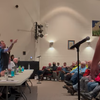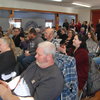New book explores a friendship forged in Partridge Run
BERNE — There’s a common and somewhat pejorative joke about how the “Lord of the Rings” series should have been called “The Very Long Walk.” The humor lies in the fact that J.R.R. Tolkien — a linguist, primarily, with a strong appreciation for nature — was in no real rush to get his characters into the kind of violent action that was more prevalent in the later film versions.
But as proven by “A Walking Friendship: The First 500 Miles,” a new book by local authors Diane Kavanaugh-Black and Carole Fults that’s predicated on their hikes through Partridge Run, in Berne, over a number of years, walking is indeed a rich and fortifying experience, and only slightly more so than reading about it (when it’s written well).
Published by Sea-Lily Publications and designed by The Troy Book Makers, “A Walking Friendship” is at its core about the bond between Kavanaugh-Black, 56, and Fults, 72, who became friends late in life, when the then-distant acquaintances found themselves the only two members of what was supposed to be a day group headed for an Adirondack hiking trip.
From that experience emerged a series of nature walks taken by the two “pokey” women, as they describe themselves, and between their first real walk together in 2012 and the publication of their book last month, they had logged just short of 500 shared miles.
But if friendship makes up the bones of the book, its flesh and blood are the secondary themes that rise up: spiritual growth, mental health, mortality, rejuvenation, cosmic unity, Earth as heaven, and life as a religion unto itself.
With some exceptions, Kavanaugh-Black handles the prose of the book, which is installed as petite essays that take a straightforward approach to the sets and settings at hand, while Fults deploys the poetry interspersed between them. They each contributed an impressive catalogue of photos, which appear on just about every other page.
“I would say, for me, the writing and the photographs inform each other,” Kavanaugh-Black told The Enterprise when asked how the authors decided what experiences were best relayed in prose, poetry, or photography.
“And sometimes I’ll make a deliberate choice,” she said. “For example, there’s an essay about a dead vole, but I’m not going to show you the photo of the vole. That needs to be described, partly because I want people to think about how they feel about photographs of death. I didn’t want to define it for people.”
“I think that, as photographers and writers,” Fults said, “we’re a channel for whatever we’re being told by the forest. So we become kind of a voice for the forest and the paths and the rivers and streams. It’s kind of directed by that.
“What would best give voice to this thing that I saw or experienced? What does it want to be? Does it want to be a poem, does it want to be a photograph, or does it want to be an essay? Or does it want to just be noticed and not be any of that?”
All elements of the book are crafted with great technical proficiency. Kavanaugh-Black’s essays are earnest but never twee, and honest but never self-indulgent.
Fults, meanwhile, digs deep into the abstract in many of her poems while maintaining the clarity of realism, and she shows the power of economy in the poem “Vernal Ponds,” which reads in full: “In the drying pond/the sleeping fairy shrimp/are dreaming water.”
Despite the vast differences in personality between the women — Kavanaugh-Black is eager in conversation and reveals in the book serious insecurities, while Fults is friendly but reserved, yet seems wholly self-assured — what they share is a naivete in how they approach the world.
While that word is used colloquially to more or less mean “stupid,” the authors embody its true meaning of “natural” (derived from the Latin word nativus), dropping all pretense and engaging the world with a youthful curiosity that sabotages the ideas of age as an absolute, and of knowledge as an achievement rather than a process.
From the authors’ note: “Any errors in plant or animal identification, habitat facts, etcetera, are completely our own. Although we enjoy researching what we find in the wild … we are not scientists, botanists, or animal behaviorists. We are absolutely aware we could be wrong about anything and everything.”
And furthering that youth is a joyous essay called “The Goddamned M-F Hill,” which captures the two women quite at the end of their ropes as they travail up the Beaver Road Hill, or, as Fults delicately puts it,“the biggest fucking hill in the history of the world.”
She finds a payoff, Kavanaugh-Black writes, in water trapped under ice at the top of the hill. “Carole points to cracked ovals — air bubbles captured in glassy waves. ‘I love this damned ice!”
Still, the women import a wisdom that can come only from a life long lived. Kavanaugh-Black states in her first essay, “The Very Beginning,” that, when she met Fults, she had recently moved cross-country, was processing a “completely unexpected divorce,” and recovering from “exhausting illness and major surgery.”
A later essay, “January Thaw,” delves into what reads as a depressive episode, or at least a suffocation from stress. “Whether it is the early darkness of the afternoon or the late darkness of the mornings, I sleep longer than I want to, resistant to pull up and out of heavy-blanketed winter slumber,” she writes. “Invisible, rime condenses on the edges of me.”
Wisely resisting any rhetorical impulse to relate depression to winter and vibrancy to summer, Kavanaugh-Black reminds readers that immersion in passion — in this case, nature, however iced-up — is a solid antidote to the blues. “Days later, I still feel the warmth of following my instincts, listening to my body’s cravings for beauty — and the walking, walking, walking. I think I’ve been thawed by the frozen.”
Fults, too, muses on immersion with a Taoist inflection in her poem, “I Walk the Labyrinth,” which reads in part:
“I walked the labyrinth with your hand in my pocket / and your voice on my shoulder. / Your shoes walked with me. / We saw the barriers in life — / You can jump them sometimes if you want / but if you do you find yourself someplace / you were supposed to be earlier or later / but not now.
“The smoothest way in or out is to follow the path / without leaping the stones, / until you reach the center / where the way of return is not what you think, / is unrecognizable, though it mirrors the way in.”
“One of the things I’ve really learned through my years of hiking and being in the forest,” Fults told The Enterprise, “is if you go there with a sense of fun and a sense of adventure, you don’t have to look real hard for things to learn. The wisdom will come and kind of smack you in the face.
“If you’re there, just relaxed and having fun, things will reveal themselves to you,” she said. “You don’t need to knock your head trying to find the big truth, or whatever, because it’s there, and it will make itself apparent.”



